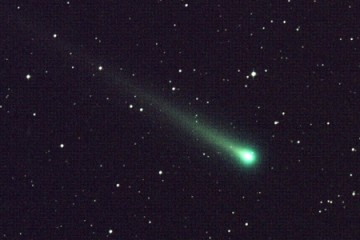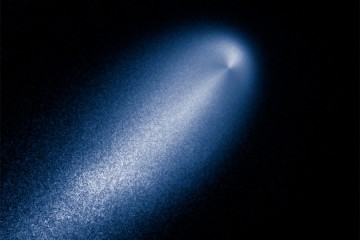On Sunday, a comet that has traveled many billions of miles will come within about 87,000 miles of Mars—about one-third of the distance of the Moon from Earth.

Image caption: Artist's conceptual image of comet Siding Spring (C/2013 A1) heading toward Mars.
Image credit: NASA
Comet Siding Spring comes from the Oort Cloud, material left over from the formation of the solar system.
Oort Cloud material, including comets, is scattered through a vast region that begins outside the orbits of Neptune and Pluto and extends a substantial portion of the distance to Proxima Centauri, the sun's closest neighboring star. By studying Oort Cloud comets, scientists can learn about the materials—including water and carbon compounds—that existed during the formation of the solar system some 4.6 billion years ago.
"The close flyby of Mars by Comet Siding Spring is unique, unexpected, and lucky for us," said David Humm, space scientist at the Johns Hopkins University Applied Physics Laboratory. "It's likely this is its first time this close to the sun."
The comet's close encounter will be studied by the largest fleet of orbiting scientific observatories ever flown to another planet. These instruments—which will orbit around Mars—will, for the first time ever, have the chance to make close-up observations of a comet new to the inner solar system.
Humm serves as instrument scientist for the Compact Reconnaissance Imaging Spectrometer for Mars (CRISM), built by APL, and one of the instruments on board NASA's Mars Reconnaissance Orbiter (MRO) that will observe Siding Spring. Two other MRO instruments will also observe the comet—the High Resolution Imaging Science Experiment (HiRISE), a high-definition camera, and the Context Imager (CTX). Together, all three imagers will attempt to capture data about Siding Spring that are unobtainable from Earth. Though Earth-based observations of Siding Spring will reveal a great deal of information, "CRISM has a significant advantage due to its proximity to the comet at closest approach," Humm said.
"CRISM is both a spectrometer and a camera," Humm added. "It can identify molecules by the light they emit and characterize minerals by the light they reflect. We can then make an image of any material we identify, and see its distribution. If we're fortunate, CRISM will be able to detect some features in the comet gas and dust, and we can make images of the distribution of different gases detected and learn something about the nature of the dust."
Siding Spring is small (the nucleus is less than a mile in diameter) and fast (it will pass Mars at about 34 miles per second). CRISM, HiRISE, and CTX were built to study a slowly moving planet, so they will use MRO's ability to rotate in order to capture images as the comet speeds by Mars. The instruments will observe the comet repeatedly for two and a half days as it gets closer and closer to Mars before it makes its closest approach. The peak density of comet dust at Mars is expected 98 minutes after closest approach of the nucleus, and the MRO spacecraft will position itself behind the planet at that time to avoid any potentially damaging high-speed dust particles that may trail the comet as it passes.
Last year's Oct. 1 encounter with Comet ISON—a sun-grazing comet that passed within 6.5 million miles of Mars—gave the teams on CRISM and the other Mars observatories a chance to practice looking at an object hurtling past the planet. But, Humm acknowledged, "Comets are very unpredictable. No two ever seem to be the same. A new comet like Siding Spring will bring surprises."
For Humm and other scientists on the CRISM and other MRO teams, an event like the encounter with Siding Spring was not even considered during construction and launch of the orbiter and its instruments back in 2005.
"I would have been very surprised if you had told me we were going to use CRISM to look at a comet," Humm said. "The likelihood of being this close to a new comet is really very small, and we're operating well beyond our design lifetime, so this exciting an opportunity is completely unexpected."
Posted in Science+Technology









